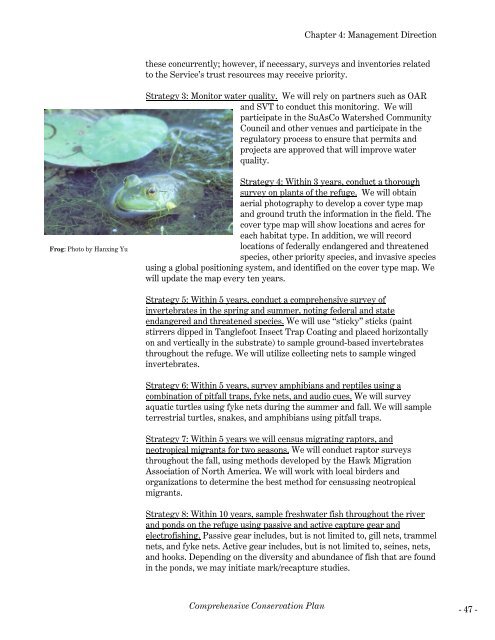Assabet River NWR Final CCP - U.S. Fish and Wildlife Service
Assabet River NWR Final CCP - U.S. Fish and Wildlife Service
Assabet River NWR Final CCP - U.S. Fish and Wildlife Service
You also want an ePaper? Increase the reach of your titles
YUMPU automatically turns print PDFs into web optimized ePapers that Google loves.
Frog: Photo by Hanxing Yu<br />
Chapter 4: Management Direction<br />
these concurrently; however, if necessary, surveys <strong>and</strong> inventories related<br />
to the <strong>Service</strong>’s trust resources may receive priority.<br />
Strategy 3: Monitor water quality. We will rely on partners such as OAR<br />
<strong>and</strong> SVT to conduct this monitoring. We will<br />
participate in the SuAsCo Watershed Community<br />
Council <strong>and</strong> other venues <strong>and</strong> participate in the<br />
regulatory process to ensure that permits <strong>and</strong><br />
projects are approved that will improve water<br />
quality.<br />
Strategy 4: Within 3 years, conduct a thorough<br />
survey on plants of the refuge. We will obtain<br />
aerial photography to develop a cover type map<br />
<strong>and</strong> ground truth the information in the field. The<br />
cover type map will show locations <strong>and</strong> acres for<br />
each habitat type. In addition, we will record<br />
locations of federally endangered <strong>and</strong> threatened<br />
species, other priority species, <strong>and</strong> invasive species<br />
using a global positioning system, <strong>and</strong> identified on the cover type map. We<br />
will update the map every ten years.<br />
Strategy 5: Within 5 years, conduct a comprehensive survey of<br />
invertebrates in the spring <strong>and</strong> summer, noting federal <strong>and</strong> state<br />
endangered <strong>and</strong> threatened species. We will use “sticky” sticks (paint<br />
stirrers dipped in Tanglefoot Insect Trap Coating <strong>and</strong> placed horizontally<br />
on <strong>and</strong> vertically in the substrate) to sample ground-based invertebrates<br />
throughout the refuge. We will utilize collecting nets to sample winged<br />
invertebrates.<br />
Strategy 6: Within 5 years, survey amphibians <strong>and</strong> reptiles using a<br />
combination of pitfall traps, fyke nets, <strong>and</strong> audio cues. We will survey<br />
aquatic turtles using fyke nets during the summer <strong>and</strong> fall. We will sample<br />
terrestrial turtles, snakes, <strong>and</strong> amphibians using pitfall traps.<br />
Strategy 7: Within 5 years we will census migrating raptors, <strong>and</strong><br />
neotropical migrants for two seasons. We will conduct raptor surveys<br />
throughout the fall, using methods developed by the Hawk Migration<br />
Association of North America. We will work with local birders <strong>and</strong><br />
organizations to determine the best method for censussing neotropical<br />
migrants.<br />
Strategy 8: Within 10 years, sample freshwater fish throughout the river<br />
<strong>and</strong> ponds on the refuge using passive <strong>and</strong> active capture gear <strong>and</strong><br />
electrofishing. Passive gear includes, but is not limited to, gill nets, trammel<br />
nets, <strong>and</strong> fyke nets. Active gear includes, but is not limited to, seines, nets,<br />
<strong>and</strong> hooks. Depending on the diversity <strong>and</strong> abundance of fish that are found<br />
in the ponds, we may initiate mark/recapture studies.<br />
Comprehensive Conservation Plan - 47 -

















